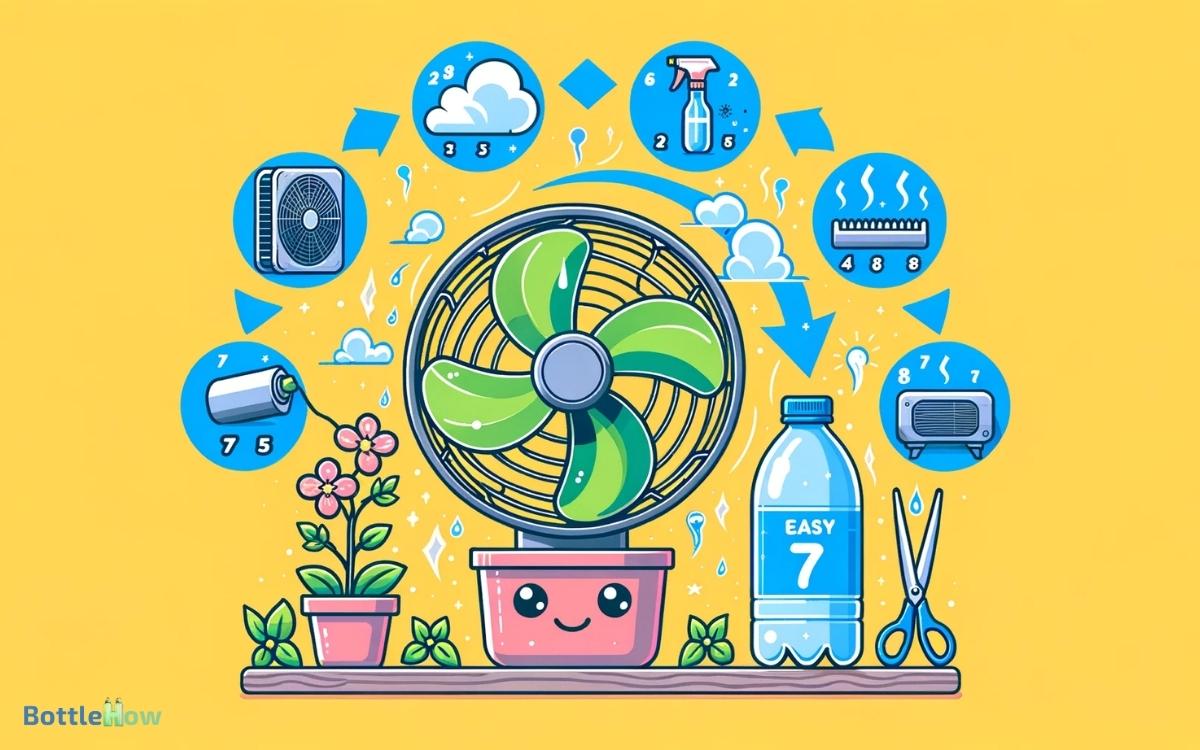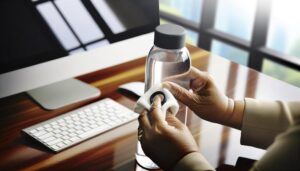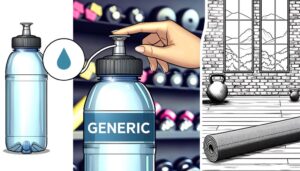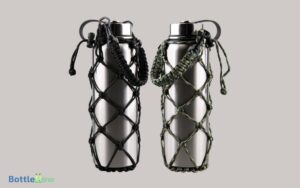Diy Air Conditioner Fan Water Bottle: A Complete Guide!
To build a DIY air conditioner using a fan and a water bottle, you’ll need a plastic water bottle, knife, ice cubes, small desk fan, and duct tape.
For a more detailed guide and expert tips, continue onward.

Key Takeaways
Materials Needed
To construct your DIY air conditioner fan with a water bottle, you’ll need the following materials:
- Clean, empty plastic water bottle
- Knife or scissors
- Ice cubes
- Small desk fan
- Duct tape
Choosing the Right Fan
When choosing a fan for your DIY air conditioner, prioritize the fan size to guarantee it can effectively circulate air through the water bottle system.
Opt for fans with higher energy efficiency ratings to reduce power consumption and maintain cost-effectiveness.
Always check the manufacturer’s specifications for airflow capacity and safety features to prevent overheating.
Fan Size Matters
Selecting the appropriate fan size is crucial for optimizing the efficiency and cooling capacity of your DIY air conditioner.
When choosing a fan, consider the cubic feet per minute (CFM) rating, which indicates the airflow volume. A higher CFM provides better cooling but may consume more power.
Make sure the fan’s diameter matches the dimensions of your container to prevent airflow leakage.
Use a fan with adjustable speed settings for better control over cooling intensity. Also, opt for a fan with safety features like a protective grille to avoid accidental contact with blades.
Secure the fan firmly to the container to prevent instability. Proper fan selection guarantees effective cooling while maintaining safety and operational efficiency.
Energy Efficiency Considerations
Evaluating the energy efficiency of your fan is crucial for creating an effective and cost-efficient DIY air conditioner. Look for fans with Energy Star ratings, which indicate lower energy consumption.
Opt for a fan with a DC (direct current) motor instead of an AC (alternating current) motor; DC motors are more efficient and quieter. Check the fan’s wattage—lower wattage means less energy use.
Confirm the fan has adjustable speed settings, allowing you to control airflow and energy use. Always follow the manufacturer’s safety guidelines when installing or operating the fan.
Avoid using high-power industrial fans, as they can be overkill and inefficient for this application. By selecting the right fan, you’ll make your DIY air conditioner both effective and energy-efficient.
Preparing the Water Bottles
First, make sure the water bottles are thoroughly cleaned to prevent any contaminants from affecting the air quality. Use warm, soapy water and a bottle brush to scrub the inside surfaces.
Rinse thoroughly to remove all soap residues, as residual soap can interfere with freezing and air quality.
Next, inspect the bottles for any cracks or damage. Compromised integrity can result in leaks, posing safety risks and decreasing efficiency. Guarantee the caps seal tightly to prevent spills during operation.
Fill the bottles with clean water, leaving about an inch of space at the top to allow for ice expansion. Seal the bottles securely.
Properly prepared water bottles are essential for the efficient and safe operation of your DIY air conditioner. These bottles should be securely sealed and frozen to maximize cooling efficiency. Using a DIY insulated water bottle can help extend the cooling duration by reducing the rate of ice melt. Proper insulation also prevents condensation buildup, keeping your setup dry and effective.
Freezing the Water Bottles
Place the prepared water bottles in the best possible part of your freezer, ensuring they stand upright to prevent any leakage during the freezing process.
Position them away from delicate items, as freezing can cause expansion and potential rupture. Allow 4-6 hours for complete freezing, ensuring the water solidifies uniformly.
Ensure you:
- Feel the satisfaction of a job well done.
- Anticipate the cool relief on a hot day.
- Know the process is safe and efficient.
Always wear insulated gloves when handling frozen bottles to avoid frostbite. Verify that the freezer temperature is set to at least 0°F (-18°C) to guarantee solidification.
Monitoring the freezing progress periodically will help you achieve the best possible results for your DIY air conditioner.
Setting Up the Fan
When setting up your DIY air conditioner, you’ll need to choose a fan with sufficient power to circulate air effectively.
Position the fan to face the area you want to cool, ensuring it’s stable to prevent any tipping hazards. Secure the frozen water bottles in front of the fan to maximize cold air distribution.
Choosing the Right Fan
Selecting the ideal fan involves evaluating its power, size, and compatibility with your DIY air conditioner setup to guarantee maximum cooling efficiency.
You’ll want a fan that provides strong airflow, ideally measured in cubic feet per minute (CFM). A higher CFM means better cooling.
Make sure the fan’s dimensions fit your setup without obstructing the water bottle’s placement. Compatibility with your power source, whether it’s USB or standard outlet, is essential for seamless operation.
Consider these factors:
- Noise Level: A quieter fan ensures a peaceful environment.
- Energy Efficiency: Choose energy-efficient models to save on power consumption.
- Safety Features: Look for fans with protective grilles and automatic shut-off options.
Positioning for Optimal Cooling
To achieve peak cooling, position the fan at an angle where it can direct airflow efficiently across the water bottle.
Place the setup on a flat, stable surface to prevent tipping. Confirm the fan’s airflow path covers the entire water bottle, maximizing evaporation and cooling.
| Step | Action | Safety Tip |
|---|---|---|
| 1 | Place the fan on a table | Verify the table is stable |
| 2 | Set the water bottle in front | Secure the bottle to avoid spills |
| 3 | Adjust the fan angle | Avoid pointing directly at face |
| 4 | Test airflow direction | Use a lightweight fabric to check |
| 5 | Fine-tune positioning | Keep electrical components dry |
Utilize these steps to optimize your DIY air conditioner’s efficiency and guarantee safe operation.
Attaching the Water Bottles
Confirm that the water bottles are securely fastened to the fan’s frame using zip ties, ensuring they won’t shift or fall during operation.
Begin by threading the zip ties through the holes in the fan’s grille and around the necks of the water bottles.
Tighten the zip ties until the bottles are firmly in place, but be cautious not to overtighten, which could cause the bottles to crack.
- Safety First: Double-check that the bottles are stable to prevent accidents.
- Efficiency Matters: Properly secured bottles enhance cooling effectiveness.
- Peace of Mind: Knowing the bottles are secure allows worry-free operation.
Trim the excess zip tie lengths with scissors to avoid any sharp edges. Make sure the bottles are evenly distributed to maintain balance and stability.
Positioning the Fan
To achieve peak fan placement, make sure the fan is positioned where it can draw in maximum air from the environment. Always secure the setup to prevent any accidental tipping or shifting.
Optimal Fan Placement
Positioning the fan correctly guarantees maximum airflow and efficiency for your DIY air conditioner. Place the fan at a slight angle to ensure ideal cooling distribution.
Elevate it to mid-room height to allow even air circulation. Make sure the water bottle is securely fastened to prevent spillage and potential electrical hazards.
- Safety First: Keep cords and wires organized to avoid tripping.
- Comfort Zone: Direct the airflow towards areas where you spend the most time.
- Stable Base: Use a sturdy surface to prevent the fan from tipping over.
Always check that the fan blades are clear of obstructions and the water bottle remains sealed tightly.
Following these guidelines will help you achieve a safer, more effective cooling setup.
Maximizing Airflow Efficiency
Guaranteeing maximum airflow efficiency involves strategically placing the fan to direct cool air precisely where it’s needed most.
Start by positioning the fan at an elevated angle, ideally about 30-45 degrees from the floor. This allows the cool air to circulate more evenly.
Make sure the fan is facing the area where you spend the most time, such as your workstation or bed.
Avoid obstructions like furniture or curtains that can impede airflow. Additionally, maintain a clear path for air to flow back to the fan, creating a continuous cooling loop.
Always check that the fan is securely placed on a stable surface to prevent tipping hazards. By following these guidelines, you’ll enhance the cooling efficiency of your DIY setup.
Securing the Setup
Securing the fan involves firmly anchoring it on a stable surface to prevent accidents and guarantee peak performance. Place the fan on a flat, non-slip surface to mitigate tipping risks.
Make sure the power cord is safely routed to avoid tripping hazards. The fan should be positioned to optimize airflow without obstruction.
- Safety First: A stable, non-slip surface prevents accidents.
- Optimal Performance: Proper positioning enhances cooling efficiency.
- Peace of Mind: Secure setup reduces worries about tipping or falling.
Testing the Cooling Effect
To test the cooling effect of your DIY air conditioner fan water bottle, first, measure the ambient room temperature using a reliable thermometer.
Place the fan and water bottle assembly in the desired location. Turn on the fan and allow it to run for at least 30 minutes.
Using the same thermometer, measure the temperature directly in front of the airflow at a consistent distance.
Compare the initial ambient temperature to the temperature in the airflow. Guarantee proper ventilation around the setup to avoid overheating the fan motor.
Document the temperature difference to evaluate effectiveness. Always handle electrical components with dry hands and confirm connections are secure to prevent short circuits.
This method provides a clear indication of the cooling efficacy of your DIY solution.
Enhancing Efficiency
While you’ve tested the cooling effect, optimizing your DIY air conditioner fan water bottle for maximum efficiency involves several key adjustments and considerations.
- First, guarantee the fan blades are clean and unobstructed to maximize airflow.
- Second, use insulated water bottles to maintain colder temperatures for extended periods.
- Third, position the fan and water bottles strategically to enhance air circulation within the room.
Maximize Airflow: Clean fan blades regularly to prevent dust build-up.
Insulate Bottles: Use insulated water bottles to keep the water colder, longer.
Strategic Placement: Place the fan and water bottles where air flows freely and reaches the entire room.
Maintenance Tips
Regularly check and replace the water in the bottles to maintain peak performance and prevent mold and bacterial growth. Use filtered or distilled water to minimize mineral deposits.
Inspect the fan blades and clean them with a damp cloth to remove dust and debris. Make sure the water bottles are securely fastened to avoid spills. Replace any cracked or damaged bottles immediately.
Periodically, disassemble the unit to inspect the tubing for clogs or leaks. Clean the tubing with a mild detergent and rinse thoroughly. If you notice reduced cooling efficiency, verify that the fan is operating at its peak speed.
Always unplug the unit before performing any maintenance tasks to avoid electrical hazards. Following these steps will keep your DIY air conditioner in top working condition.
Safety Precautions
Prioritizing your safety, always make sure the DIY air conditioner is unplugged before conducting any maintenance or inspection tasks. This prevents electrical shocks and ensures your workspace remains hazard-free.
Ensure the fan blades are stationary to avoid accidental cuts. Keep the water bottle securely fastened to prevent leaks that could cause electrical shorts.
- Avoid Overloading: Never plug the DIY air conditioner into an overloaded power strip or extension cord.
- Check for Wear: Regularly inspect the fan’s power cord for fraying or damage to prevent electrical fires.
- Ventilation: Make sure the fan has adequate ventilation to avoid overheating, which could lead to malfunctions.
These steps are essential for maintaining a safe and efficient DIY air conditioning setup.
Alternative Cooling Methods
Many alternative cooling methods exist that can complement or replace your DIY air conditioner setup, each with its own set of advantages and technical considerations.
Evaporative coolers, or swamp coolers, use water evaporation to cool the air, ideal for dry climates. Guarantee you maintain proper airflow and humidity levels to prevent mold.
Another option is geothermal cooling, which utilizes the Earth’s stable underground temperatures. This method requires installing pipes and a heat exchanger but offers efficient, long-term cooling.
Ceiling fans can also improve airflow; make sure blades are set to spin counterclockwise in summer.
Always consider insulation improvements, as well. Insulating your home reduces heat gain, making any cooling method more effective. Prioritize safety and consult professionals when needed.
Conclusion
You might doubt if a DIY air conditioner with a fan and water bottles can genuinely cool your space, but it’s surprisingly effective.
By following these steps, you’ll create an eco-friendly, cost-efficient cooling solution. Plus, you’ll enjoy the satisfaction of your own handiwork.
Remember, regularly maintain your setup and adhere to safety guidelines to maximize efficiency.
Trust us, you’ll relish the cool comfort and the sense of accomplishment from your DIY project.






